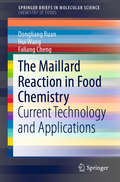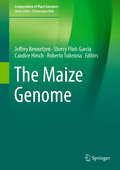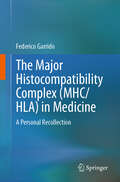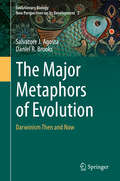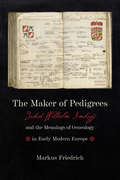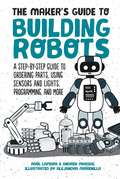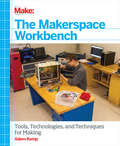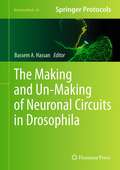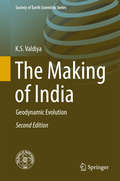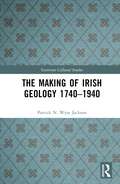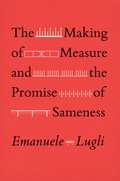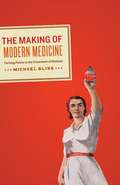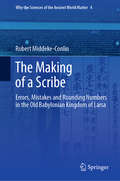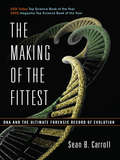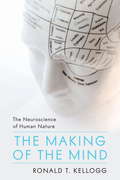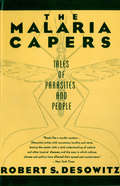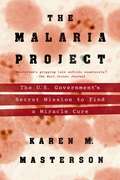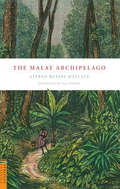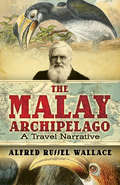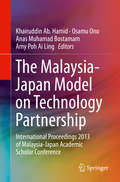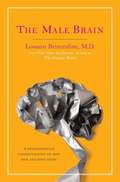- Table View
- List View
The Maillard Reaction in Food Chemistry: Current Technology and Applications (SpringerBriefs in Molecular Science)
by Dongliang Ruan Hui Wang Faliang ChengThis book is devoted to the characterization of Maillard reaction products using mass spectrometry (MS)-based technologies. The Maillard reaction is a well-known non-enzymatic reaction between reducing sugars and proteins, and one of the most important reactions in food sciences. The authors explore different MS-based technologies to systematically investigate the Maillard reaction from amino acids, peptides and proteins. By using amino acid/peptide-sugar models, the authors also show how reactants, temperature and time affect the Maillard reaction. In this book, readers will learn more about glucosylation, and how it can improve functional properties of food proteins.
The Maize Genome (Compendium of Plant Genomes)
by Roberto Tuberosa Jeffrey Bennetzen Sherry Flint-Garcia Candice HirschThis book discusses advances in our understanding of the structure and function of the maize genome since publication of the original B73 reference genome in 2009, and the progress in translating this knowledge into basic biology and trait improvement. Maize is an extremely important crop, providing a large proportion of the world’s human caloric intake and animal feed, and serving as a model species for basic and applied research. The exceptionally high level of genetic diversity within maize presents opportunities and challenges in all aspects of maize genetics, from sequencing and genotyping to linking genotypes to phenotypes. Topics covered in this timely book range from (i) genome sequencing and genotyping techniques, (ii) genome features such as centromeres and epigenetic regulation, (iii) tools and resources available for trait genomics, to (iv) applications of allele mining and genomics-assisted breeding. This book is a valuable resource for researchers and students interested in maize genetics and genomics.
The Major Histocompatibility Complex (MHC/ HLA) in Medicine: A Personal Recollection
by Federico GarridoThis book takes the reader on a journey through past and current research on the Major Histocompatibility Complex (MHC/HLA). It describes how it was discovered, what its biological function is and its application in medicine. The reader will learn about the molecular structure of the encoded molecules and different aspects of their role in medicine, including organ transplantation, their link to autoimmune diseases, cancer immunity, resistance to infectious diseases, and other related scientific areas, such as population genetics. In particular, the book focusses on the impact of MHC/HLA altered expression in tumours and their relevance in cancer immune escape and immunotherapy. It contains a large number of original figures and photographs of pioneers in the field, who made seminal contributions. Each chapter is supported by relevant key publications and enriched with a personal account of the early research that has contributed to our current understanding of the role of the major histocompatibility complex. This book is an excellent resource for all scientists in the biomedical life sciences who wish to gain insight into the discovery of the MHC/HLA and the role of this important genetic complex in health and disease.
The Major Metaphors of Evolution: Darwinism Then and Now (Evolutionary Biology – New Perspectives on Its Development #2)
by Daniel R. Brooks Salvatore J. AgostaThis book presents a unified evolutionary framework based on three sets of metaphors that will help to consolidate discussions on evolutionary transitions.Evolution is the unifying principle of life, making identifying ways to apply evolutionary principles to tackle existence-threatening crises such as climate change crucial. A more cohesive evolutionary framework will further the discussions in this regard and also accelerate the process itself.This book lays out a framework based on three dualistic classes of metaphors – time, space, and conflict resolution. Evolutionary transitions theory shows how metaphors can help us understand selective diversification, as Darwin described with his “tree of life”. Moreover, the recently proposed Stockholm paradigm demonstrates how metaphors can help shed light on the emergence of complex ecosystems that Darwin highlighted with his “tangled bank” metaphor. Taken together, these ideas offer proactive measures for coping with existential crises for humanity, such as climate change.The book will appeal to biologists, philosophers and historians alike.
The Maker of Pedigrees: Jakob Wilhelm Imhoff and the Meanings of Genealogy in Early Modern Europe (Information Cultures)
by Markus FriedrichA history of genealogical knowledge-making strategies in the early modern world.In The Maker of Pedigrees, Markus Friedrich explores the complex and fascinating world of central European genealogy practices during the Baroque era. Drawing on archival material from a dozen European institutions, Friedrich reconstructs how knowledge about noble families was created, authenticated, circulated, and published. Jakob Wilhelm Imhoff, a wealthy and well-connected patrician from Nuremberg, built a European community of genealogists by assembling a transnational network of cooperators and informants. Friedrich uses Imhoff as a case study in how knowledge was produced and disseminated during the 17th and 18th centuries.Family lineages were key instruments in defining dynasties, organizing international relations, and structuring social life. Yet in the early modern world, knowledge about genealogy was cumbersome to acquire, difficult to authenticate, and complex to publish. Genealogy's status as a source of power and identity became even more ambivalent as the 17th century wore on, as the field continued to fragment into a plurality of increasingly contradictory formats and approaches. Genealogy became a contested body of knowledge, as a heterogeneous set of actors—including aristocrats, antiquaries, and publishers—competed for authority. Imhoff was closely connected to all of the major genealogical cultures of his time, and he serves as a useful prism through which the complex field of genealogy can be studied in its bewildering richness.
The Maker's Guide to Building Robots: A Step-by-Step Guide to Ordering Parts, Using Sensors and Lights, Programming, and More
by Raúl Laperia Andreu MarsalDiscover that our lives are surrounded by robots. Learn what they are, where they come from and their importance today as well as meeting some of the most famous robots in history! You see them at the movies and on TV, but you also have them in the kitchen and on your computer. They help us to forecast the weather, they adjust the fridge temperature and they vacuum the dust from our homes in our absence. Robots are everywhere! But we love this invasion. Little by little, these creatures have almost become our best friends. That’s why you need to get to know them well, to know how they work and what their use is. You will find all this and much more in this book. In addition, you will learn how to build your own robot. That’s a good plan, right? Quick! Find your favorite seat, get yourself comfy, open this book, and say hello to our robots!
The Makerspace Workbench: Tools, Technologies, and Techniques for Making
by Adam KempCreate a dynamic space for designing and building DIY electronic hardware, programming, and manufacturing projects. With this illustrated guide, you’ll learn the benefits of having a Makerspace—a shared space with a set of shared tools—that attracts fellow makers and gives you more resources to work with. You’ll find clear explanations of the tools, software, materials, and layout you need to get started—everything from basic electronics to rapid prototyping technology and inexpensive 3D printers.A Makerspace is the perfect solution for many makers today. While you can get a lot done in a fully-decked out shop, you’ll always have trouble making space for the next great tool you need. And the one thing you really miss out on in a personal shop is the collaboration with other makers. A Makerspace provides you with the best of both worlds.Perfect for any maker, educator, or community, this book shows you how to organize your environment to provide a safe and fun workflow, and demonstrates how you can use that space to educate others.
The Making Of The British Army
by Allan MallinsonEdgehill, 1642: Surveying the disastrous scene in the aftermath of the first battle of the English Civil War, Oliver Cromwell realized that war could no longer be waged in the old, feudal way: there had to be system and discipline, and therefore - eventually - a standing professional army.From the 'New Model Army' of Cromwell's distant vision, former soldier Allan Mallinson shows us the people and events that have shaped the British army we know today. How Marlborough's momentous victory at Blenheim is linked to Wellington's at Waterloo; how the desperate fight at Rorke's Drift in 1879 underpinned the heroism of the airborne forces at Arnhem in 1944; and why Montgomery's momentous victory at El Alamein mattered long after the Second World War was over . . . From the British Army's origins at the battle of Edgehill to the recent conflict in Afghanistan, The Making of the British Army is history at its most relevant - and most dramatic.
The Making and Un-Making of Neuronal Circuits in Drosophila
by Bassem A. HassanThe small fruit fly, Drosophila melanogaster, has for over a century now had a large impact on biological and biomedical research; however, our knowledge of the fly brain has lagged significantly behind our understanding of other aspects of its development, physiology, and function. In The Making and Un-Making of Neuronal Circuits in Drosophila, innovative expert neuroscientists in the field present the ideas and concepts behind the methods, tools, and tricks that are currently being utilized to decode the secrets of this valuable insect's brain. Focused on the concept of a neuronal circuit, defined as a series of synaptically connected neurons subservient to a particular behavioral modality, this volume contains chapters dealing with anatomical analysis with a focus on cellular and sub-cellular morphologies. These detailed approaches fall under the headings of "Physiology" and "Behavior", conveniently divided the book into two sections. Written in the easy-to-follow Neuromethods series format, this work provides the kind of detailed description and implementation advice that is crucial for getting optimal results. Inventive and accessible, The Making and Un-Making of Neuronal Circuits in Drosophila provides the information and tools necessary to carry out current experiments and, more importantly, further advance the progress of the Drosophila neurobiology field and neurobiology in general.
The Making of India
by K. S. ValdiyaThis book presents in a concise format a simplified and coherent geological-dynamical history of the Indian subcontinent (including Sri Lanka, Bangladesh, Myanmar, Southern Tibet and Pakistan). Encompassing a broad array of information related to structure and tectonics, stratigraphy and palaeontology, sedimentation and palaeogeography, petrology and geochemistry, geomorphology and geophysics, it explores the geodynamic developments that took place from the beginning around 3. 4 billion years ago to the last about 5,000 years before present. Presented in a distilled form, the observations and deductions of practitioners, this book is meant for teachers, researchers and students of geology, geophysics and geomorphology and practitioners of earth sciences. A comprehensive list of references to original works provides guidance for those seeking further details and who wish to examine selected problems in depth. The book is illustrated with a wealth of maps, cross sections and block diagrams -- all simplified and redesigned.
The Making of Irish Geology 1740–1940 (Variorum Collected Studies)
by Patrick N. Wyse JacksonIreland has long been the focus of research into its geological foundations and history. This book provides insights into the evolution of geological ideas in Ireland, gives assessments of underrepresented scientists, and offers an appreciation of the value of geological collections for historical research.Through a series of twenty-two papers, this volume provides syntheses and analyses of aspects of this geological research and places the role of a number of individuals firmly within context. The topics discussed include the considerations of the nature of igneous rocks, aspects of geological mapping of the country, the role played by Irish scientists in determining the age of the Earth, and the importance of early mineralogical and geological collectors and the role their collections made to advancing geological knowledge both in Ireland and Europe. The Making of Irish Geology 1740–1940 will appeal to both the general and academic reader interested in the development of the geological sciences, with a particular focus on Ireland.
The Making of Measure and the Promise of Sameness
by Emanuele LugliAn interdisciplinary history of standardized measurements. Measurement is all around us—from the circumference of a pizza to the square footage of an apartment, from the length of a newborn baby to the number of miles between neighboring towns. Whether inches or miles, centimeters or kilometers, measures of distance stand at the very foundation of everything we do, so much so that we take them for granted. Yet, this has not always been the case. This book reaches back to medieval Italy to speak of a time when measurements were displayed in the open, showing how such a deceptively simple innovation triggered a chain of cultural transformations whose consequences are visible today on a global scale. Drawing from literary works and frescoes, architectural surveys, and legal compilations, Emanuele Lugli offers a history of material practices widely overlooked by historians. He argues that the public display of measurements in Italy’s newly formed city republics not only laid the foundation for now centuries-old practices of making, but also helped to legitimize local governments and shore up church power, buttressing fantasies of exactitude and certainty that linger to this day. This ambitious, truly interdisciplinary book explains how measurements, rather than being mere descriptors of the real, themselves work as powerful molds of ideas, affecting our notions of what we consider similar, accurate, and truthful.
The Making of Modern Medicine: Turning Points in the Treatment of Disease
by Michael BlissAt the dawn of the twenty-first century, we have become accustomed to medical breakthroughs and conditioned to assume that, regardless of illnesses, doctors almost certainly will be able to help—not just by diagnosing us and alleviating our pain, but by actually treating or even curing diseases, and significantly improving our lives. For most of human history, however, that was far from the case, as veteran medical historian Michael Bliss explains in The Making of Modern Medicine. Focusing on a few key moments in the transformation of medical care, Bliss reveals the way that new discoveries and new approaches led doctors and patients alike to discard fatalism and their traditional religious acceptance of suffering in favor of a new faith in health care and in the capacity of doctors to treat disease. He takes readers in his account to three turning points—a devastating smallpox outbreak in Montreal in 1885, the founding of the Johns Hopkins Hospital and Medical School, and the discovery of insulin—and recounts the lives of three crucial figures—researcher Frederick Banting, surgeon Harvey Cushing, and physician William Osler—turning medical history into a fascinating story of dedication and discovery.Compact and compelling, this searching history vividly depicts and explains the emergence of modern medicine—and, in a provocative epilogue, outlines the paradoxes and confusions underlying our contemporary understanding of disease, death, and life itself.
The Making of a Scribe: Errors, Mistakes and Rounding Numbers in the Old Babylonian Kingdom of Larsa (Why the Sciences of the Ancient World Matter #4)
by Robert Middeke-ConlinThis book presents a novel methodology to study economic texts. The author investigates discrepancies in these writings by focusing on errors, mistakes, and rounding numbers. In particular, he looks at the acquisition, use, and development of practical mathematics in an ancient society: The Old Babylonian kingdom of Larsa (beginning of the second millennium BCE Southern Iraq). In so doing, coverage bridges a gap between the sciences and humanities. Through this work, the reader will gain insight into discrepancies encountered in economic texts in general and rounding numbers in particular. They will learn a new framework to explain error as a form of economic practice. Researchers and students will also become aware of the numerical and metrological basis for calculation in these writings and how the scribes themselves conceptualized value. This work fills a void in Assyriological studies. It provides a methodology to explore, understand, and exploit statistical data. The anlaysis also fills a void in the history of mathematics by presenting historians of mathematics a method to study practical texts. In addition, the author shows the importance mathematics has as a tool for ancient practitioners to cope with complex economic processes. This serves as a useful case study for modern policy makers into the importance of education in any economy.
The Making of the Fittest: DNA and the Ultimate Forensic Record of Evolution
by Sean B. CarrollDNA evidence not only solves crimes--in Sean Carroll's hands it will now end the Evolution Wars. DNA, the genetic blueprint of all creatures, is a stunningly rich and detailed record of evolution. Every change or new trait, from the gaudy colors of tropical birds to our color vision with which we admire them, is due to changes in DNA that leave a record and can be traced. Just as importantly, the DNA evidence has revealed several profound surprises about how evolution actually works.
The Making of the Mind
by Ronald T. KelloggUsing the findings of recent neuroscience, a psychologist reveals what sets humans apart from all other species, offering a fascinating exploration of our marvelous and sometimes frightening cognitive abilities and potentials. According to human genome research, there is a remarkable degree of overlap in the DNA of humans and chimpanzees. So what accounts for the rapid development of human culture throughout history and the extraordinary creative and destructive aspects of human behavior that make us so different from our primate cousins? Kellogg explores in detail five distinctive parts of human cognition. These are the executive functions of working memory; a social intelligence with "mind-reading" abilities; a capacity for symbolic thought and language; an inner voice that interprets conscious experiences by making causal inferences; and a means for mental time travel to past events and imagined futures. He argues that it is the interaction of these five components that results in our uniquely human mind. This is especially true for three quintessentially human endeavors-morality, spirituality, and literacy, which can be understood only in light of the whole ensemble's interactive effects. Kellogg recaps the story of the human mind and speculates on its future. How might the Internet, 24/7 television, and smart phones affect the way the mind functions?
The Malaria Capers: Tales Of Parasites And People
by Robert S. Desowitz"Reads like a murder mystery…[Desowitz] writes with uncommon lucidity and verse, leaving the reader with a vivid understanding of malaria and other tropical diseases, and the ways in which culture, climate and politics have affected their spread and containment." —New York Times Why, Robert S. Desowitz asks, has biotechnical research on malaria produced so little when it had promised so much? An expert in tropical diseases, Desowtiz searches for answers in this provocative book.
The Malaria Project
by Karen M. MastersonA fascinating and shocking historical exposé, The Malaria Project is the story of America's secret mission to combat malaria during World War II--a campaign modeled after a German project which tested experimental drugs on men gone mad from syphilis. American war planners, foreseeing the tactical need for a malaria drug, recreated the German model, then grew it tenfold. Quickly becoming the biggest and most important medical initiative of the war, the project tasked dozens of the country's top research scientists and university labs to find a treatment to remedy half a million U.S. troops incapacitated by malaria. Spearheading the new U.S. effort was Dr. Lowell T. Coggeshall, the son of a poor Indiana farmer whose persistent drive and curiosity led him to become one of the most innovative thinkers in solving the malaria problem. He recruited private corporations, such as today's Squibb and Eli Lilly, and the nation's best chemists out of Harvard and Johns Hopkins to make novel compounds that skilled technicians tested on birds. Giants in the field of clinical research, including the future NIH director James Shannon, then tested the drugs on mental health patients and convicted criminals--including infamous murderer Nathan Leopold. By 1943, a dozen strains of malaria brought home in the veins of sick soldiers were injected into these human guinea pigs for drug studies. After hundreds of trials and many deaths, they found their "magic bullet," but not in a U.S. laboratory. America 's best weapon against malaria, still used today, was captured in battle from the Nazis. Called chloroquine, it went on to save more lives than any other drug in history. Karen M. Masterson, a journalist turned malaria researcher, uncovers the complete story behind this dark tale of science, medicine and war. Illuminating, riveting and surprising, The Malaria Project captures the ethical perils of seeking treatments for disease while ignoring the human condition.
The Malay Archipelago (Periplus Classics Series)
by Alfred Russel WallaceThis is one the first and most important books about 18th century Malaysia and covers a wide array of topics from Malaysian culture and history to nature and wildlife. It is essential reading for anyone interested in Malaysia.<P><P>A century and a half after it was first published, this book remains one of the great classics of natural history and travel--perhaps the greatest. Alfred Russel Wallace (1823-1913) deserves equal billing with Charles Darwin for his independently drawn but parallel conclusions on the theory of evolution. Darwin himself called Wallace "generous and noble" and referred favorably to his work in later editions of The Origin of Species.The Malay Archipelago is an extraordinarily accessible book. There is a wealth of detail about pre-modern life in the Indonesian archipelago which Wallace accumulated on over 60 separate journeys spanning 14,000 miles. He was equally fascinated by the exotic peoples, flora and fauna he encountered in his epic travels. A mark of his achievement lies in the size of the collections he bequeathed to British museums--some 125,000 specimens ranging from large mammals to tiny insects, exotic butterflies and splendid birds of paradise.
The Malay Archipelago: A Travel Narrative
by Alfred Russel WallaceWritten by a famed 19th-century scientist who laid the groundwork for much of modern biology, this influential work remains one of the great classics of natural history and travel. Detailing his eight-year exploration of the Malay Archipelago, Wallace offers observations of the native people of the island groupings, the abundant and strange animals and insects, and more.
The Malaysia-Japan Model on Technology Partnership
by Khairuddin Ab. Hamid Osamu Ono Anas Muhamad Bostamam Amy Poh Ai LingThe selected papers included in this proceedings on Malaysia-Japan Academic Scholar Conference (MJASC) 2013, are related to nano-science engineering, mechanical engineering, electrical and electronic engineering, computer science, information technology etc. This proceedings will be a source of research findings for Malaysia and Japan specifically, and other countries in general, especially among researchers, industry sectors and government policy makers. It will be served as a resourceful reference and platform to reflect the significant of the Look East Policy outcomes and products.
The Male Brain: A Breakthrough Understanding of How Men and Boys Think
by Louann BrizendineA breezy and enlightening guide to women and a must-read for men, this book is the eagerly awaited follow-up book that demystifies the puzzling male brain.
The Male Brain: A Breakthrough Understanding of How Men and Boys Think
by Louann BrizendineFrom the author of the groundbreaking New York Times bestseller The Female Brain, here is the eagerly awaited follow-up book that demystifies the puzzling male brain. Dr. Louann Brizendine, the founder of the first clinic in the country to study gender differences in brain, behavior, and hormones, turns her attention to the male brain, showing how, through every phase of life, the "male reality" is fundamentally different from the female one. Exploring the latest breakthroughs in male psychology and neurology with her trademark accessibility and candor, she reveals that the male brain: *is a lean, mean, problem-solving machine. Faced with a personal problem, a man will use his analytical brain structures, not his emotional ones, to find a solution. *thrives under competition, instinctively plays rough and is obsessed with rank and hierarchy. *has an area for sexual pursuit that is 2.5 times larger than the female brain, consuming him with sexual fantasies about female body parts. *experiences such a massive increase in testosterone at puberty that he perceive others' faces to be more aggressive.The Male Brain finally overturns the stereotypes. Impeccably researched and at the cutting edge of scientific knowledge, this is a book that every man, and especially every woman bedeviled by a man, will need to own.Praise for The Female Brain:"Louann Brizendine has done a great favor for every man who wants to understand the puzzling women in his life. A breezy and enlightening guide to women and a must-read for men."--Daniel Goleman, author of Emotional Intelligence From the Hardcover edition.
